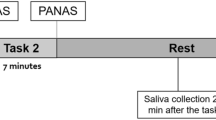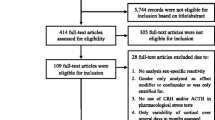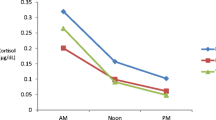Abstract
Autism is a hereditary, pervasive neurodevelopmental disorder that starts early in life. The main characteristics of the autism are impairment in social interactions, difficulties in adapting to novel environmental situations and improper reaction to stress. Since the Hypothalamic-Pituitary-Adrenocortical (HPA) axis plays a key role in the response to stress and because the previous research found abnormalities in HPA system, we conducted a study to test several elements of the HPA axis. Because autism is a heritable disorder, autistic subjects were studied as well as their parents. Cortisol circadian rhythm, cortisol daily secretion and its suppression response to dexamethason had been measured from saliva or urine samples of the autistic children and their parents. Cortisol secretion response after ACTH stimulation was done with the autistic children only. The cortisol elevation after ACTH stimulation among the autistic individuals was slower (P = 0.017) than in healthy controls. No differences were found in salivary cortisol circadian rhythm or suppression response, as well as in cortisol daily excretion. These data indicate that, compared to healthy subjects, autistic individuals have fine differences in cortisol response to ACTH stimulation or possibly to other types of stress.


Similar content being viewed by others
References
American Psychiatric Association (1994) Diagnostic and statistical manual of Mental disorders, (4th edn, rev). Author, Washington, DC
Aylward EH, Minshev NJ, Goldstein G, Honeycutt NA, Augustine AM, Yates KO, Barta PE, Pearlson GD (1999) MRI volumes of amygdala and hippocampus in not mentally retarded autistic adolescents and adults. Neurology 53:2145–2150
Corbett BA, Mendosa S, Abdullah M, Wegelin JA, Levine S (2006) Cortisol circadian rhythms and response to stress in children with autism. Psychoneuroendochrinology 31:59–68
Dawson G (2001) The search for autism’s roots. Nature 41:882–884
Harris B, Watkins S, Cook N, Walker RF, Read GF, Riad-Fahmy D (1990) Comparisons of plasma and salivary cortisol determinations for the diagnostic efficacy of the dexametasone suppression test. Biol Psychiatry 27:897–904
Herbert J (1998) Neurosteroids, brain damage, and mental illnes. Exp Gerontol 33:713–727
Hrdlicka M, Dudlova I, Beranova I, Lisy J, Belsan T, Neuwirth J, Komarek V, Faladova L, Havlovicova M, Sedlacek Z, Blatny M, Urbanek T (2005) Subtypes of autism by cluster analysis based on srtuctural MRI data. Eur Child Adolesc Psychiatry 14:138–144
Jacobson L (2005) Hypothalamic-pituitary-adrenocortical axis regulation. Endocrinol Metab Clin North Am 34:271–292
Jansen LM, Gispen-de Wied CC, van der Gaag RJ, ten Hove F, Willemsen-Swinkels SW, Harteveld E, Engeland H (2000) Unresponsivness to psychosocial stress in subgroup of autistic-like children, multiple complex developmental disorder. Psychoneuroendocrinology 25:753–764
Jansen LM, Gispen-de Wied CC, van der Gaag RJ, van Engeland F (2003) Differentiation between autism and multiple complex developmental disorder in response to psychosocial stress. Neuropsychopharmachology 28:582–590
KiessW, Meidert A, Dressendorfer RA, Schriever K, Kessler U, Konig A, Schwarz HP, Strasburger CJ (1995) Salivary cortisol levels throughout childhood and adolescence: relation with age, pubertal stage, and weight. Pediatr Res 37:502–506
Lainhart JE (1997) Developmental abnormalities in autism. Lancet 349:373–374
Lifshitz F (1996) Pediatric endocrinology, (3rd edn). Mercel-Dekkor Inc., New York
Marinovic-Curin J, Terzic J, Bujas-Petkovic Z, Zekan LJ, Marinovic-Terzic I, Marasovic-Susnjara I (2003) Lower cortisol and higher ACTH levels in individuals with autism. J Autism Dev Disord 33:443–448
Mash EJ, Russell AB (2003) Child psychopathology, (2nd edn). The Guilford Press, New York
Matarazzo EB (2002) Treatment of late onset autism as a consequence of probable autoimmune processes related to chronic bacterial infection. World J Biol Psychiatry 3:162–166
Molloy CA, Manning-Courtney P (2003) Prevalence of chronic gastrointestinal symptoms in children with autism and autistic spectrum disorders. Autism 7:165–171
Nir I, Meir D, Zilber N, Knobler H, Hadjez J, Lerner Y (1995) Brief report: circadian melatonin, thyroid-stimulating hormone, prolactin, and cortisol levels in serum of young adults with autism. J Autism Dev Disorder 25:641–654
Palmen SJ, van England H, Hof PR, Shmitz C (2004) Neuropathological findings in autism. Brain 127:2572–2583
Ranke MB (2003) Diagnostics of endocrine function in children and adolescents, (1st edn). Karger, Basel
Richdale AL, Prior MR (1992) Urinary cortisol circadian rhythm in a group of High functioning children with autism. J Autism Dev Disord 22:433–447
Rojas DC, Smith JA, Benkers TL, Camou SL, Reite ML, Rogers SJ (2004) Hippocampus and amygdala volume in parents of children with autistic disorder. Am J Psychiatry 161:2038–2044
Sandman CA, Barron JL, Chiez-DeMet A, DeMet EM (1991) Brief report: plasma beta endorfin and cortisol levels in autistic patients. J Autism Dev Disord 21:83–87
Shao Y, Cuccaro ML, Hauser ER, Raiford KL, Menold M, Wolpert CM, Ravan SA, Elston L, Decena K, Donnelly SL, Abramson RK, Wright HH, Delong GR, Gilbert JR, Pericak-Vance MA (2003) Fine mapping of autistic disorder to chromosome15q11-q13 by use of phenotypic subtypes. Am J Hum Genet 72:539–548
Stokstad E (2001) New hints into the biological basis of autism. Science 294:34–37
Strous RD, Golubchik P, Maayan R, Mozes T, Tuati-Werner D, Weizman A, Spivak B (2005) Lowered DHEA-S plasma levels in adult individuals with autistic disorder. Eur Neuropsychopharmacol 15:305–309
Tordjman S, Anderson GM, McBride PA, Hertzing ME, Snow ME, Hall LM, Thompson SM, Ferrari P, Cohen DJ (1997) Plasma beta-endorfin, adrenocorticotropin hormone, and cortisol in autism. J Child Psychol Psychiatry 38:705–715
Trottier G, Srivastava L, Walker CD (1999) Etiology of infantile autism: a review of recent advances in genetic and neurobiological research. J Psychiatry Neurosci 24:103–115
Vedhara K, Hyde J, Gilchrist ID, Tytherleigh M, Plummer S (2000) Acute stress, memory, attention and cortisol. Psychoneuroendocrinology 25:535–549
Veenstra-van der Weele J, Cook EH (2004) Molecular genetics of autism spectrum disorder. Mol Psychiatry 7:73–78
Wassink TH, Brzustowicz LM, Bartlett CW, Szatmari P (2004) The search of Autism disease genes. Ment Retard Dev Disabil Res Rev 10:272–283
Waterhouse L, Fein D, Modahl C (1996) Neurofunctional mehanisms in autism. Psychol Rev 103:457–489
Wolft S (2004) The history of autism. Eur Child Adolesc Psychiatry 13:201–208
Acknowledgement
We thank to all the children with autism and parents that participated in the study. Also, we are very thankful to the personnel of the «Center for Autism» in Split and Zagreb.
Author information
Authors and Affiliations
Corresponding author
Rights and permissions
About this article
Cite this article
Marinović-Ćurin, J., Marinović-Terzić, I., Bujas-Petković, Z. et al. Slower cortisol response during ACTH stimulation test in autistic children. Eur Child Adolesc Psychiatry 17, 39–43 (2008). https://doi.org/10.1007/s00787-007-0632-1
Accepted:
Published:
Issue Date:
DOI: https://doi.org/10.1007/s00787-007-0632-1




